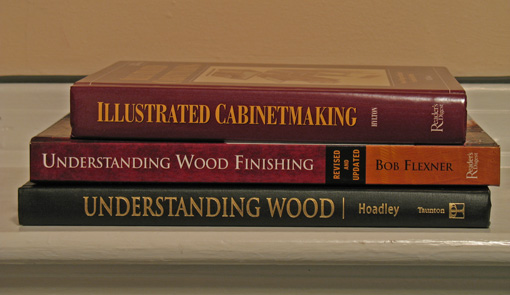• Wednesday, November 12th, 2008

There are so many excellent sources to read for woodworking skills that it is difficult to sort through what is available to come up with recommendations. So I will start here with three selections that are easy choices, clear gems, first ballot hall-of-famers.
Understanding Wood, by R. Bruce Hoadley, may be the one book that I would say every woodworker should have. One cannot go very far in improving woodworking skills without understanding the material and no source is better for this fundamental knowledge. Dr. Hoadley, professor emeritus in the Department of Building Materials and Wood Technology at the University of Massachusetts, Amherst, shows how the biological structure of wood determines its physical and working properties. This is not disconnected science but rather is practical knowledge that will make you a better woodworker. First published in 1980, it was revised in 2000. (The free Forest Products Laboratory Wood Handbook is a good backup to Understanding Wood.)
Illustrated Cabinetmaking, by Bill Hylton, is a wonderful go-to book when you’re contemplating a project and need to study the options for how to put something together. What are the choices for constructing drawer runners? How much elbow room is needed for a person at a dining table? What are different ways to design a chest of drawers? If a martian landed on earth and wanted to learn as quickly as possible how humans build furniture, I’d hand him this book.
Understanding Wood Finishing, by Bob Flexner, doesn’t just show you how to finish wood, it brings you to an understanding of the subject so that soon you’ll be answering your own finishing questions. I think Bob Flexner’s book and his articles in Popular Woodworking magazine (and a nice collection of many of his articles ) are not only some of the best explanatory writings in the field of woodworking, but some of the best I’ve read on any topic! (I’m not worthy…)
Being always a student of this craft, I will in this blog continue to revisit the topic of learning resources.
• Tuesday, October 28th, 2008
For an enjoyable woodworking experience visit the Lie-Nielsen Hand Tool Event, December 5&6, 2008 (Friday and Saturday) at the Sturbridge Host Hotel, Sturbridge, Massachusetts. Chris Becksvoort, Bob Van Dyke, and I will be among the demonstrators showing techniques and talking tools and woodworking. This is a fun and informative opportunity to try out top quality hand tools and pick up skills and tips at the many workstations. This is a relaxed, hands-on event. Admission is free.
• Saturday, October 25th, 2008
You’ve got some apple wood and want to know its shrinkage properties before working it into your project. Where do you go? FPL, of course. Here’s some more help in searching through this resource.
Forest Products Laboratory’s very helpful Tech Sheets, available for many wood species, are most easily accessed here which brings you to an index with categories of species. I am not able to find a direct link to this index on the FPL homepage. I emailed them suggesting they include this convenience.
Another route is to type the common name of the wood, e.g. “cherry”, in the Search box in the upper left corner of the homepage. For most species, you will find at least one item in the results with “Tech Sheet” which will lead you to either the sheet itself or an index from which you can go to the desired species.
Wood. It’s good.
• Friday, October 03rd, 2008
The Forest Products Laboratory is the best source of information on that wonderful stuff that we woodworkers cherish so dearly – wood. As I graze the woodworking literature in print and online, it seems the FPL does not get the attention it warrants. It is an authoritative and amazingly extensive source.
From the FPL website the entire Wood Handbook, all 15 MB and 508 pages, can be downloaded. I keep the pdf copy on my hard drive. This book is a treasure chest of wood information – structure, physical properties of various species, grading, fasteners, gluing, finishing, etc. It does not spell out woodworking technique but it provides the kind of hard data that can form the basis for rational woodworking methodology. Making a frame and panel and want to know the shrinkage values for butternut? Page 59. Hmm…about like cherry, I’m familiar with cherry, so ok …
Look up the Tech Sheet for a species and you will get to a Technology Transfer Fact Sheet with more information than you may ever want about that species.
And on and on, there’s a ton of useful and interesting information here. (Did I mention that it’s free?)


